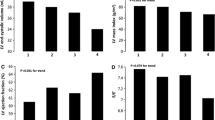Abstract
Background
It has been reported that the diastolic wall strain (DWS) inversely correlates with the myocardial stiffness constant. The ratio of early diastolic transmitral flow velocity to annulus velocity (E/E′) correlates with the left ventricular (LV) filling pressure. Increased LV wall stiffness is thought be associated with increased LV filling pressure after exercise. The purpose of this study was to evaluate the correlation between the DWS and post-exercise E/E′ in elderly patients without obvious myocardial ischemia.
Methods
Fifty-eight elderly patients (age = 74 ± 6 years) who underwent treadmill stress echocardiography were studied. All patients had normal LV wall motion at rest, and patients with exercise-induced wall motion abnormality were excluded. The DWS was calculated as follows: DWS = (PWTs − PWTd)/PWTs, where PWTs is the LV posterior wall thickness at end-systole and PWTd is that at end-diastole. As previously reported, DWS ≤ 0.33 was defined as low DWS and E/E′ ≥15.0 was defined as a marker of increased LV filling pressure.
Results
Eighteen patients had low DWS. Patients with low DWS had greater post-exercise E/E′ (17.9 ± 3.2 vs. 12.8 ± 3.3, p < 0.0001). The DWS was inversely and strongly correlated with post-exercise E/E′ (r 2 = 0.534, p < 0.0001). Low DWS predicted the development of raised post-exercise E/E′ ≥15.0 with a positive predictive value of 94 % and a negative predictive value of 85 %.
Conclusion
In elderly patients without obvious myocardial ischemia, the DWS correlates strongly and inversely with post-exercise E/E′. Patients with low DWS were likely to develop raised E/E′ after exercise.


Similar content being viewed by others
References
Senni M, Tribouilloy CM, Rodeheffer RJ, et al. Congestive heart failure in the community: a study of all incident cases in Olmsted County, Minnesota, in 1991. Circulation. 1998;98:2282–9.
Vasan RS, Larson MG, Benjamin EJ, et al. Congestive heart failure in subjects with normal versus reduced left ventricular ejection fraction: prevalence and mortality in a population-based cohort. J Am Coll Cardiol. 1999;33:1948–55.
Owan TE, Hodge DO, Herges RM, et al. Trends in prevalence and outcome of heart failure with preserved ejection fraction. N Engl J Med. 2006;355:251–9.
Nagueh SF, Middleton KJ, Kopelen HA, et al. Doppler tissue imaging: a noninvasive technique for evaluation of left ventricular relaxation and estimation of filling pressures. J Am Coll Cardiol. 1997;30:1527–33.
Ommen SR, Nishimura RA, Appleton CP, et al. Clinical utility of Doppler echocardiography and tissue Doppler imaging in the estimation of left ventricular filling pressures: a comparative simultaneous Doppler-catheterization study. Circulation. 2000;102:1788–94.
Ha JW, Oh JK, Pellikka PA, et al. Diastolic stress echocardiography: a novel noninvasive diagnostic test for diastolic dysfunction using supine bicycle exercise Doppler echocardiography. J Am Soc Echocardiogr. 2005;18:63–8.
Burgess MI, Jenkins C, Sharman JE, et al. Diastolic stress echocardiography: hemodynamic validation and clinical significance of estimation of ventricular filling pressure with exercise. J Am Coll Cardiol. 2006;47:1891–900.
Talreja DR, Nishimura RA, Oh JK. Estimation of left ventricular filling pressure with exercise by Doppler echocardiography in patients with normal systolic function: a simultaneous echocardiographic-cardiac catheterization study. J Am Soc Echocardiogr. 2007;20:477–9.
Takeda Y, Sakata Y, Higashimori M, et al. Noninvasive assessment of wall distensibility with the evaluation of diastolic epicardial movement. J Card Fail. 2009;15:68–77.
Ohtani T, Mohammed SF, Yamamoto K, et al. Diastolic stiffness as assessed by diastolic wall strain is associated with adverse remodelling and poor outcomes in heart failure with preserved ejection fraction. Eur Heart J. 2012;33:1742–9.
Lang RM, Bierig M, Devereux RB, et al. Recommendations for chamber quantification: a report from the American Society of Echocardiography’s Guidelines and Standards Committee and the Chamber Quantification Writing Group, developed in conjunction with the European Association of Echocardiography, a branch of the European Society of Cardiology. J Am Soc Echocardiogr. 2005;18:1440–63.
Takagi T, Takagi A, Yoshikawa J. Detection of coronary artery disease using delayed strain imaging at 5 min after the termination of exercise stress: head to head comparison with conventional treadmill stress echocardiography. J Cardiol. 2010;55:41–8.
Takagi T, Yoshikawa J. Diastolic stress echocardiography in Japanese elderly patients: prevalence and features of patients with elevated left ventricular filling pressure after treadmill stress. J Echocardiogr. 2011;9:17–23.
Takagi T, Takagi A, Yoshikawa J. Elevated left ventricular filling pressure estimated by E/E′ ratio after exercise predicts development of new-onset atrial fibrillation independently of left atrial enlargement among elderly patients without obvious myocardial ischemia. J Cardiol. 2014;63:128–33.
Kitzman DW, Higginbotham MB, Cobb FR, et al. Exercise intolerance in patients with heart failure and preserved left ventricular systolic function: failure of the Frank–Starling mechanism. J Am Coll Cardiol. 1991;17:1065–72.
Holland DJ, Prasad SB, Marwick TH. Prognostic implications of left ventricular filling pressure with exercise. Circ Cardiovasc Imaging. 2010;3:149–56.
Conflict of interest
Tsutomu Takagi has received honoraria of $1000 or less as a lecture fee from the following companies: Astellas Pharma Inc., AstraZeneca K.K., Bayer Yakuhin Ltd., Boehringer Ingelheim Japan Inc., Kowa Pharmaceutical Co., Ltd., MSD K.K., Shionogi & Co., Ltd., Novartis Pharma K.K., and Takeda Pharmaceutical Co., Ltd.
Atsushi Takagi declares that he has no conflict of interest.
Junichi Yoshikawa declares that he has no conflict of interest.
Human rights statement and informed consent
All procedures followed were in accordance with the ethical standards of the responsible committee on human experimentation (institutional and national) and with the Helsinki Declaration of 1975, as revised in 2000(5). Informed consent was obtained from all patients for being included in the study.
Author information
Authors and Affiliations
Corresponding author
Rights and permissions
About this article
Cite this article
Takagi, T., Takagi, A. & Yoshikawa, J. Low diastolic wall strain is associated with raised post-exercise E/E′ ratio in elderly patients without obvious myocardial ischemia. J Echocardiogr 12, 106–111 (2014). https://doi.org/10.1007/s12574-014-0225-1
Received:
Revised:
Accepted:
Published:
Issue Date:
DOI: https://doi.org/10.1007/s12574-014-0225-1




